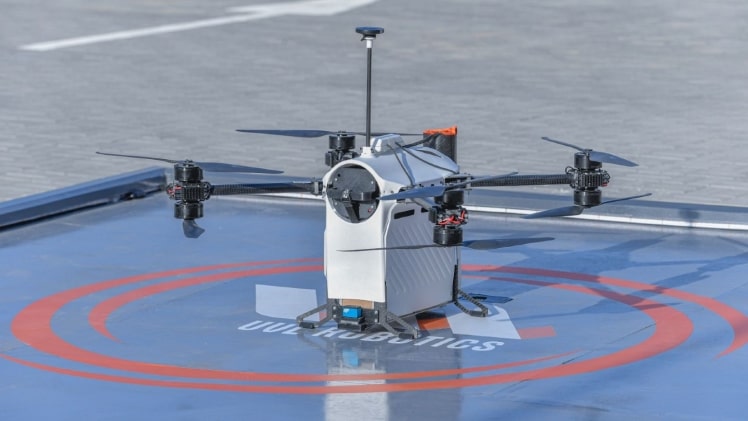Introduction
By 2030, drones will have a significant impact on the food delivery industry due to the numerous potential advantages they provide over conventional delivery methods. Food may be delivered quickly, effectively, and reliably to a wide range of locations using drones, including difficult-to-reach locations like high-rise buildings and remote areas. Additionally, by reducing the need for automobiles and other forms of transportation, the use of drones for food delivery may contribute to the App Development Toronto reduction of the food industry’s impact on the environment. I’ll be looking at some of the possibilities that drone-based delivery will soon bring in this post.
Why are drone deliveries superior?
There are a number of reasons why drone deliveries may be quicker and more effective than human food delivery. For one thing, drones can get to their destination faster because they don’t have to worry about traffic or other road obstacles. Additionally, unlike human food delivery drivers, who may need to park and walk to reach their destination, drones, can fly directly to a specific location. In the end, using drones to deliver food can cut down on the amount of labor required and the costs associated with overhead.
Drones may reduce the cost of foodservice delivery for customers
In recent trials, autonomous delivery vehicles (robots) have taken to the streets and skies as major delivery influencers attempt to challenge the established foodservice delivery order. Simply put, despite the fact that they are still in the test phase, drones could deliver a meal directly to the consumer’s door from the point of preparation. To navigate even dense urban environments, drones make use of a variety of cutting-edge technologies like GPS, computer imagery, and collision avoidance technology.
Drones could reduce delivery times, expand coverage areas, and offset high-volume orders during peak hours in a perfect delivery world with feasible drone technology and appropriate legislation. Most importantly, drones could offset operational costs and pass savings on to customers, making delivery a more affordable and appealing option for a wider range of customers. The technology needs to be improved and legislation will be a challenge, but it appears that drones are coming, which could be beneficial to consumers.
Automation reduces costs
Drones are just one aspect of a larger trend toward automation in the foodservice industry. Technology is being incorporated into every facet of the foodservice industry, making operational procedures less expensive and more cost-effective. Through mobile apps, self-service kiosks, and cutting-edge payment terminals, technology is enhancing “back-of-house” operations and engaging customers. Delivery has also been greatly impacted by technology. Digital channels, primarily mobile apps, have been used by third-party delivery aggregators to streamline the process of selecting a cuisine, comparing prices, placing an order, and making a payment.
Software has accounted for the majority of the technology utilized in foodservice delivery thus far. On the other hand, drones are a brand-new application of high-tech hardware that has the potential to significantly alter the “cost factor.” It is anticipated that operating drones will be less expensive and more effective than operating conventional delivery mechanisms. Like other automated processes in the foodservice industry, delivery companies of the App Development Canada may be able to pass savings on to customers if they can use drones to offset operational expenses. Delivery may become a more significant driver of foodservice sales as a result, and this may make delivery more cost-effective for a greater number of customers.
Initial adopters
In any case, that is the long-term objective, and some early adopters hope to be a part of that change wave. The UK’s third-party delivery aggregator Just Eat successfully tested its first robot delivery in London at the beginning of December. The company collaborated with the technology company Starship Technologies to develop a land-based robot with wheels (shown below) that could successfully navigate London’s cobblestone streets and deliver takeout to a customer without human assistance.
The tech-friendly pizza chain Domino’s Pizza has tested its own land-based drone, DRU (Domino’s Robotic Unit), which would deliver its own in-house products but had similar goals. In addition, Domino’s has experimented with aerial delivery through a partnership with Flirty, a tech startup specializing in drones based in San Francisco. In a recent test, the company used a drone to deliver pizza in a rural area of New Zealand under tightly controlled conditions.
Making use of the technology
Both kinds of drones could help operators get the most coverage possible. It may be possible to send an aerial drone to complete the task, even though it may not be cost-effective to deliver to far-flung rural households. In a similar vein, land-based drones might be better suited to urban settings due to the shorter delivery distances and admittedly riskier skies.
Legislation that both embraces drones and keeps up with the pace of technology advancement is likely to be slow to pass. Although Amazon, a US-based e-commerce giant, is investing heavily in drones to not only improve delivery routes between distribution points but also to provide customers with delivery via aerial drone from smaller neighborhood distribution centers within hours of ordering, the technology also needs to be improved. It seems reasonable to anticipate that the technology will rapidly advance, inspiring other businesses to follow suit, given Amazon’s financial power and general enthusiasm.
Conclusion
One of their greatest advantages is the autonomous food delivery app Toronto of food by bots and drones. Consequently, food delivery businesses can reduce the amount of time and effort required to fulfill customer orders, thereby increasing efficiency and speed.

